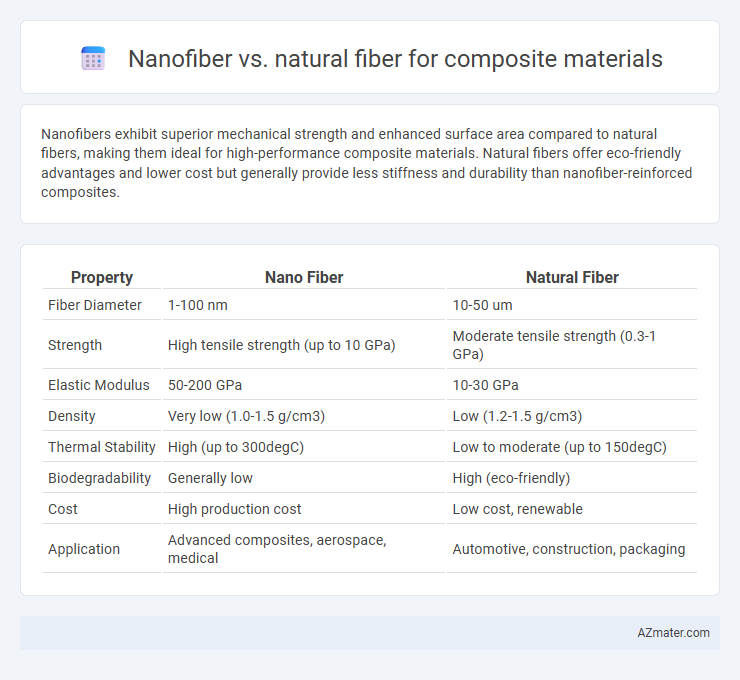Nanofibers exhibit superior mechanical strength and enhanced surface area compared to natural fibers, making them ideal for high-performance composite materials. Natural fibers offer eco-friendly advantages and lower cost but generally provide less stiffness and durability than nanofiber-reinforced composites.
Table of Comparison
| Property | Nano Fiber | Natural Fiber |
|---|---|---|
| Fiber Diameter | 1-100 nm | 10-50 um |
| Strength | High tensile strength (up to 10 GPa) | Moderate tensile strength (0.3-1 GPa) |
| Elastic Modulus | 50-200 GPa | 10-30 GPa |
| Density | Very low (1.0-1.5 g/cm3) | Low (1.2-1.5 g/cm3) |
| Thermal Stability | High (up to 300degC) | Low to moderate (up to 150degC) |
| Biodegradability | Generally low | High (eco-friendly) |
| Cost | High production cost | Low cost, renewable |
| Application | Advanced composites, aerospace, medical | Automotive, construction, packaging |
Introduction to Composite Materials
Composite materials combine two or more distinct phases to achieve superior mechanical properties, with fiber reinforcements playing a crucial role in determining strength and durability. Nanofibers offer exceptional surface area and enhanced mechanical performance at the nanoscale, while natural fibers provide sustainability, biodegradability, and cost-effectiveness. The choice between nanofiber and natural fiber reinforcements depends on application-specific requirements such as load-bearing capacity, environmental impact, and manufacturing processes.
Overview of Nano Fibers
Nano fibers in composite materials offer exceptional mechanical strength, high surface area, and enhanced interfacial bonding compared to natural fibers. Their nanoscale dimensions allow for improved load transfer and superior durability, making them ideal for high-performance applications. Unlike natural fibers, nano fibers provide greater control over fiber morphology and functionalization, resulting in customized composite properties.
Overview of Natural Fibers
Natural fibers such as jute, flax, hemp, and coir are widely used in composite materials due to their biodegradability, low cost, and renewable nature. These fibers offer moderate mechanical properties, including tensile strength and impact resistance, making them suitable for lightweight applications in automotive and construction industries. However, natural fibers exhibit variability in quality and lower durability compared to synthetic or nano fibers, necessitating surface treatments or hybridization to improve composite performance.
Mechanical Properties Comparison
Nano fibers exhibit superior mechanical properties compared to natural fibers in composite materials, offering higher tensile strength and enhanced stiffness due to their nanoscale diameter and high aspect ratio. Natural fibers, such as jute or hemp, provide moderate strength and are environmentally friendly but typically show lower impact resistance and modulus values. The integration of nano fibers into composites significantly improves load transfer efficiency and fracture toughness, resulting in advanced performance for high-strength applications.
Environmental Impact and Sustainability
Nano fibers offer significant environmental benefits in composite materials due to their high strength-to-weight ratio, which reduces material usage and energy consumption during production. Natural fibers, derived from renewable resources like hemp, flax, and jute, enhance sustainability by being biodegradable and requiring less energy-intensive processing compared to synthetic alternatives. Combining nano fibers with natural fibers in composites can optimize mechanical performance while minimizing ecological footprint, promoting eco-friendly material innovation.
Cost Analysis: Nano vs Natural Fibers
Nano fibers typically incur higher production costs due to advanced manufacturing techniques and specialized equipment, whereas natural fibers offer a cost-effective and sustainable alternative with lower raw material expenses. Despite the premium price, nano fibers provide superior mechanical properties and enhanced performance in composite materials, potentially reducing overall lifecycle costs in high-performance applications. Cost efficiency in composites often depends on balancing initial investment with durability and application-specific requirements, favoring natural fibers for economical mass production and nano fibers for cutting-edge, high-value uses.
Processing Techniques and Compatibility
Nanofibers exhibit superior compatibility with polymer matrices in composite materials due to their high surface area and ability to form strong interfacial bonds through advanced processing techniques such as electrospinning and chemical vapor deposition. Natural fibers, although biodegradable and renewable, often require surface treatments like alkali or silane coupling agents to improve adhesion and reduce moisture absorption during processing methods like compression molding and resin transfer molding. The optimized integration of nanofibers enhances mechanical properties and durability, while treated natural fibers contribute to eco-friendly composites with moderate performance.
Performance in Structural Applications
Nano fibers exhibit superior mechanical properties such as high tensile strength, enhanced stiffness, and improved impact resistance compared to natural fibers, making them ideal for high-performance structural composites. The nanoscale dimensions of nano fibers enable better stress transfer and stronger interfacial bonding with polymer matrices, resulting in composites with enhanced durability and fatigue resistance. Natural fibers offer sustainability and biodegradability but generally provide lower mechanical performance and are more sensitive to environmental degradation, limiting their use in demanding structural applications.
Durability and Aging Resistance
Nano fibers in composite materials exhibit superior durability and aging resistance compared to natural fibers due to their high surface area and enhanced interfacial bonding with the matrix. Natural fibers, prone to moisture absorption and UV degradation, typically show reduced mechanical performance over time in composite applications. Incorporating nano fibers improves composite longevity by minimizing microcrack formation and resisting environmental stressors more effectively than natural fibers.
Future Trends in Composite Fiber Materials
Nano fibers offer superior mechanical strength, enhanced thermal stability, and increased surface area compared to natural fibers, driving their adoption in high-performance composite applications. Emerging research focuses on combining nano fibers with natural fibers to create hybrid composites that balance sustainability and advanced material properties. Future trends emphasize the development of bio-based nano fibers and recyclable composite systems to meet environmental regulations and circular economy goals in industries such as aerospace and automotive.

Infographic: Nano fiber vs Natural fiber for Composite material
 azmater.com
azmater.com